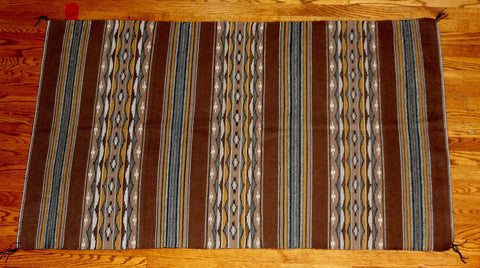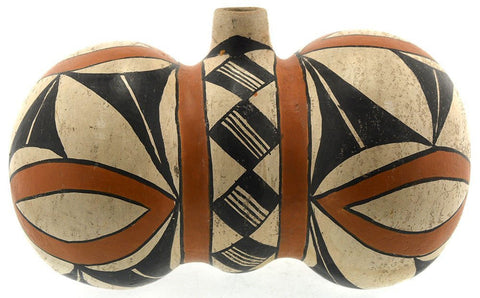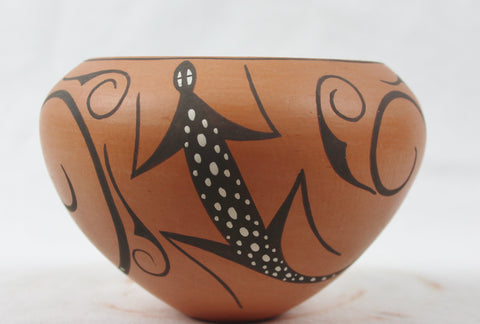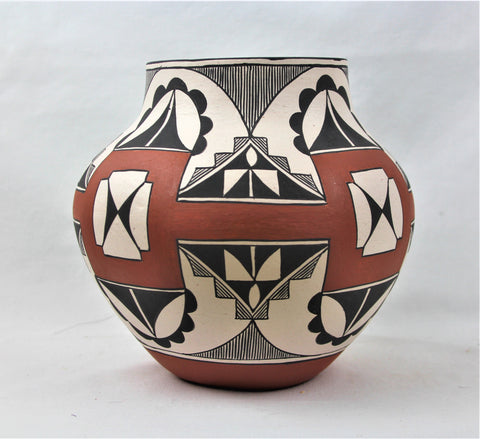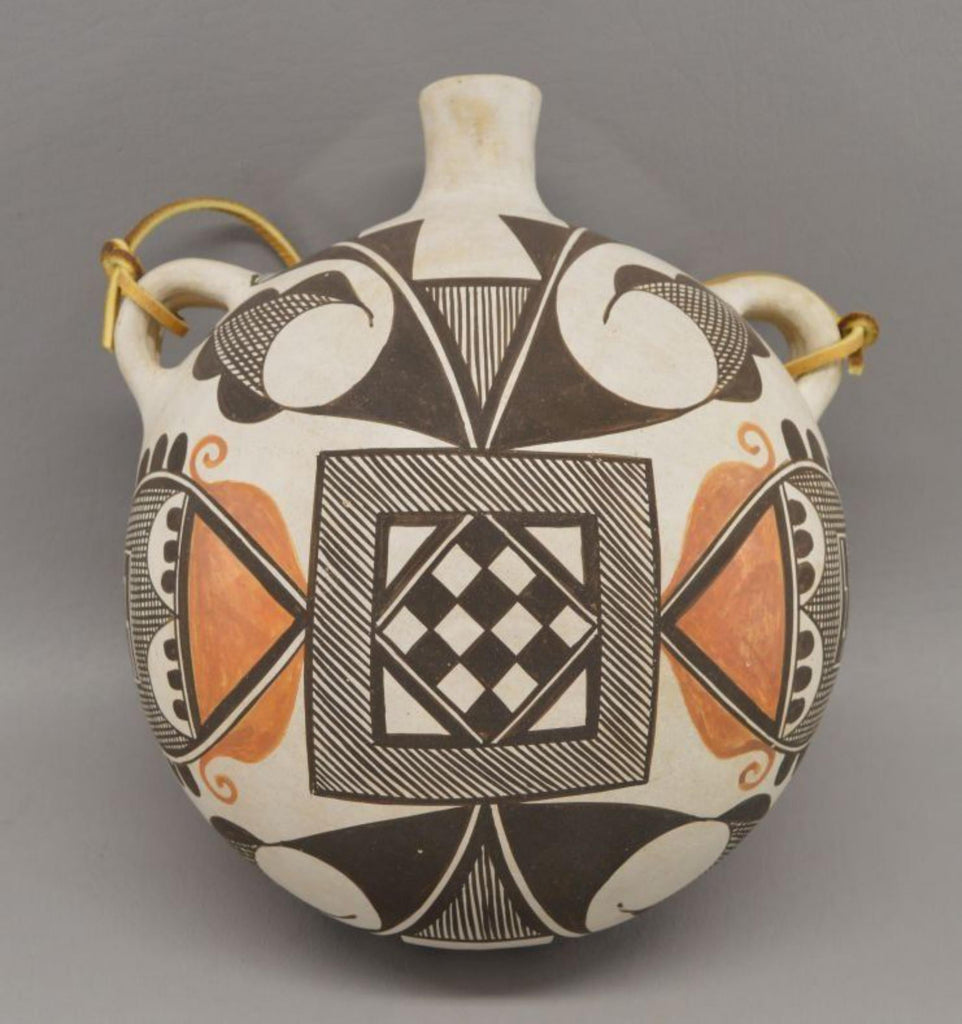
Native American Vintage Acoma Polychrome Pottery Canteen, by Juana Leno, Ca 1990's, #1578 SOLD
$ 2,750.00
Native American Vintage Acoma Polychrome Pottery Canteen, by Juana Leno, Ca 1990's, #1578
Description: #1578 Native American Vintage Acoma Polychrome Pottery Canteen, by Juana Leno, Ca 1990's
Dimensions: 9" x 8" x 6"
Condition: Very good for age, has some minor surface pits.
Juana Leno was one of the finest potters of the 20th century at Acoma Pueblo. She quietly worked every day producing extraordinary pottery without seeking acclaim. She was a wonderful woman and very modest about her talent to produce such fine pieces.
Juana Leno (1917-2000) Syo-ee-mee (Turquoise) - formerly Juana Louis Vallo may not have achieved the fame she was due, but it was not because of the lack of quality in her work, but because she chose to remain quietly at home and not seek fame.
For years, I drove out to her home at Acomita and purchased pottery from her, and I was always charmed by how graceful she was and what beautiful work she produced. She was one of the few Acoma potters from whom I purchased. —Alexander E. Anthony, Jr. (Source: Adobe Gallery.
Juana Leno is one of the four matriarchs of contemporary Acoma pottery (including Marie Z. Chino, Lucy Lewis, and Jessie Garcia). She was a daughter of Lupita and Jose Vallo. She was the mother of Rose Leno Chavez, Mary J. Leno, and Regina Leno-Shutiva. She learned to make pottery from her grandmother Eulilia Vallo. She was known for her revival of black and white Tularosa and Anasazi designs. She was also known by her Acoma name, “Syo-ee-mee (Turquoise). Over the years she won numerous awards for her work and has work in museum collections nationwide. (Source: King Galleries)
Juana Leno is known for work with the dense Acoma clay that allowed her to produce pieces that are thin and light weight. The pieces are white with either red or black designs with the characteristic fine lines and geometric patterns. These designs were often seen only on shards of Tularosa and Anasazi pots. Leno also produced work with polychrome images. Typically she used a paint brush made from leaves of the Yucca plant.
Juana Leno was born and lived in Acoma Pueblo where she was a respected pottery master. (Source: The Marks Project)
“Pueblo pottery is made using a coiled technique that came into northern Arizona and New Mexico from the south, some 1500 years ago. In the four-corners region of the US, nineteen pueblos and villages have historically produced pottery. Although each of these pueblos use similar traditional methods of coiling, shaping, finishing and firing, the pottery from each is distinctive. Various clays gathered from each pueblo’s local sources produce pottery colors that range from buff to earthy yellows, oranges, and reds, as well as black. Fired pots are sometimes left plain and other times decorated—most frequently with paint and occasionally with applique. Painted designs vary from pueblo to pueblo, yet share an ancient iconography based on abstract representations of clouds, rain, feathers, birds, plants, animals and other natural world features.
Tempering materials and paints, also from natural sources, contribute further to the distinctiveness of each pueblo’s pottery. Some paints are derived from plants, others from minerals. Before firing, potters in some pueblos apply a light colored slip to their pottery, which creates a bright background for painted designs or simply a lighter color plain ware vessel. Designs are painted on before firing, traditionally with a brush fashioned from yucca fiber.
Different combinations of paint color, clay color, and slips are characteristic of different pueblos. Among them are black on cream, black on buff, black on red, dark brown and dark red on white (as found in Zuni pottery), matte red on red, and poly chrome—a number of natural colors on one vessel (most typically associated with Hopi). Pueblo potters also produce un-decorated polished black ware, black on black ware, and carved red and carved black wares.
Making pueblo pottery is a time-consuming effort that includes gathering and preparing the clay, building and shaping the coiled pot, gathering plants to make the colored dyes, constructing yucca brushes, and, often, making a clay slip. While some Pueblo artists fire in kilns, most still fire in the traditional way in an outside fire pit, covering their vessels with large potsherds and dried sheep dung. Pottery is left to bake for many hours, producing a high-fired result.
Today, Pueblo potters continue to honor this centuries-old tradition of hand-coiled pottery production, yet value the need for contemporary artistic expression as well. They continue to improve their style, methods and designs, often combining traditional and contemporary techniques to create striking new works of art.” (Source: Museum of Northern Arizona)
Description: #1578 Native American Vintage Acoma Polychrome Pottery Canteen, by Juana Leno, Ca 1990's
Dimensions: 9" x 8" x 6"
Condition: Very good for age, has some minor surface pits.
Juana Leno was one of the finest potters of the 20th century at Acoma Pueblo. She quietly worked every day producing extraordinary pottery without seeking acclaim. She was a wonderful woman and very modest about her talent to produce such fine pieces.
Juana Leno (1917-2000) Syo-ee-mee (Turquoise) - formerly Juana Louis Vallo may not have achieved the fame she was due, but it was not because of the lack of quality in her work, but because she chose to remain quietly at home and not seek fame.
For years, I drove out to her home at Acomita and purchased pottery from her, and I was always charmed by how graceful she was and what beautiful work she produced. She was one of the few Acoma potters from whom I purchased. —Alexander E. Anthony, Jr. (Source: Adobe Gallery.
Juana Leno is one of the four matriarchs of contemporary Acoma pottery (including Marie Z. Chino, Lucy Lewis, and Jessie Garcia). She was a daughter of Lupita and Jose Vallo. She was the mother of Rose Leno Chavez, Mary J. Leno, and Regina Leno-Shutiva. She learned to make pottery from her grandmother Eulilia Vallo. She was known for her revival of black and white Tularosa and Anasazi designs. She was also known by her Acoma name, “Syo-ee-mee (Turquoise). Over the years she won numerous awards for her work and has work in museum collections nationwide. (Source: King Galleries)
Juana Leno is known for work with the dense Acoma clay that allowed her to produce pieces that are thin and light weight. The pieces are white with either red or black designs with the characteristic fine lines and geometric patterns. These designs were often seen only on shards of Tularosa and Anasazi pots. Leno also produced work with polychrome images. Typically she used a paint brush made from leaves of the Yucca plant.
Juana Leno was born and lived in Acoma Pueblo where she was a respected pottery master. (Source: The Marks Project)
“Pueblo pottery is made using a coiled technique that came into northern Arizona and New Mexico from the south, some 1500 years ago. In the four-corners region of the US, nineteen pueblos and villages have historically produced pottery. Although each of these pueblos use similar traditional methods of coiling, shaping, finishing and firing, the pottery from each is distinctive. Various clays gathered from each pueblo’s local sources produce pottery colors that range from buff to earthy yellows, oranges, and reds, as well as black. Fired pots are sometimes left plain and other times decorated—most frequently with paint and occasionally with applique. Painted designs vary from pueblo to pueblo, yet share an ancient iconography based on abstract representations of clouds, rain, feathers, birds, plants, animals and other natural world features.
Tempering materials and paints, also from natural sources, contribute further to the distinctiveness of each pueblo’s pottery. Some paints are derived from plants, others from minerals. Before firing, potters in some pueblos apply a light colored slip to their pottery, which creates a bright background for painted designs or simply a lighter color plain ware vessel. Designs are painted on before firing, traditionally with a brush fashioned from yucca fiber.
Different combinations of paint color, clay color, and slips are characteristic of different pueblos. Among them are black on cream, black on buff, black on red, dark brown and dark red on white (as found in Zuni pottery), matte red on red, and poly chrome—a number of natural colors on one vessel (most typically associated with Hopi). Pueblo potters also produce un-decorated polished black ware, black on black ware, and carved red and carved black wares.
Making pueblo pottery is a time-consuming effort that includes gathering and preparing the clay, building and shaping the coiled pot, gathering plants to make the colored dyes, constructing yucca brushes, and, often, making a clay slip. While some Pueblo artists fire in kilns, most still fire in the traditional way in an outside fire pit, covering their vessels with large potsherds and dried sheep dung. Pottery is left to bake for many hours, producing a high-fired result.
Today, Pueblo potters continue to honor this centuries-old tradition of hand-coiled pottery production, yet value the need for contemporary artistic expression as well. They continue to improve their style, methods and designs, often combining traditional and contemporary techniques to create striking new works of art.” (Source: Museum of Northern Arizona)
Related Products
Sold out
Sold out
Sold out








